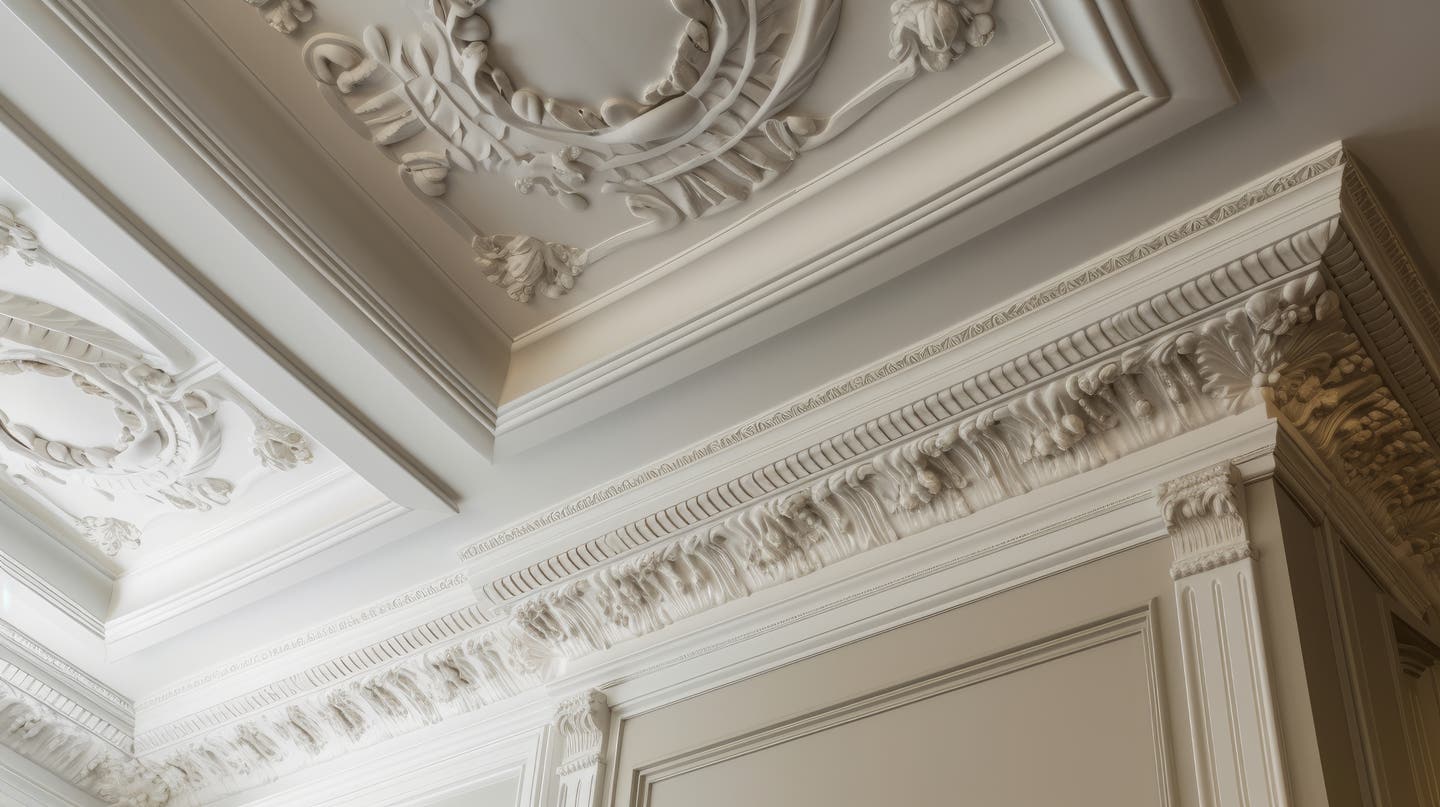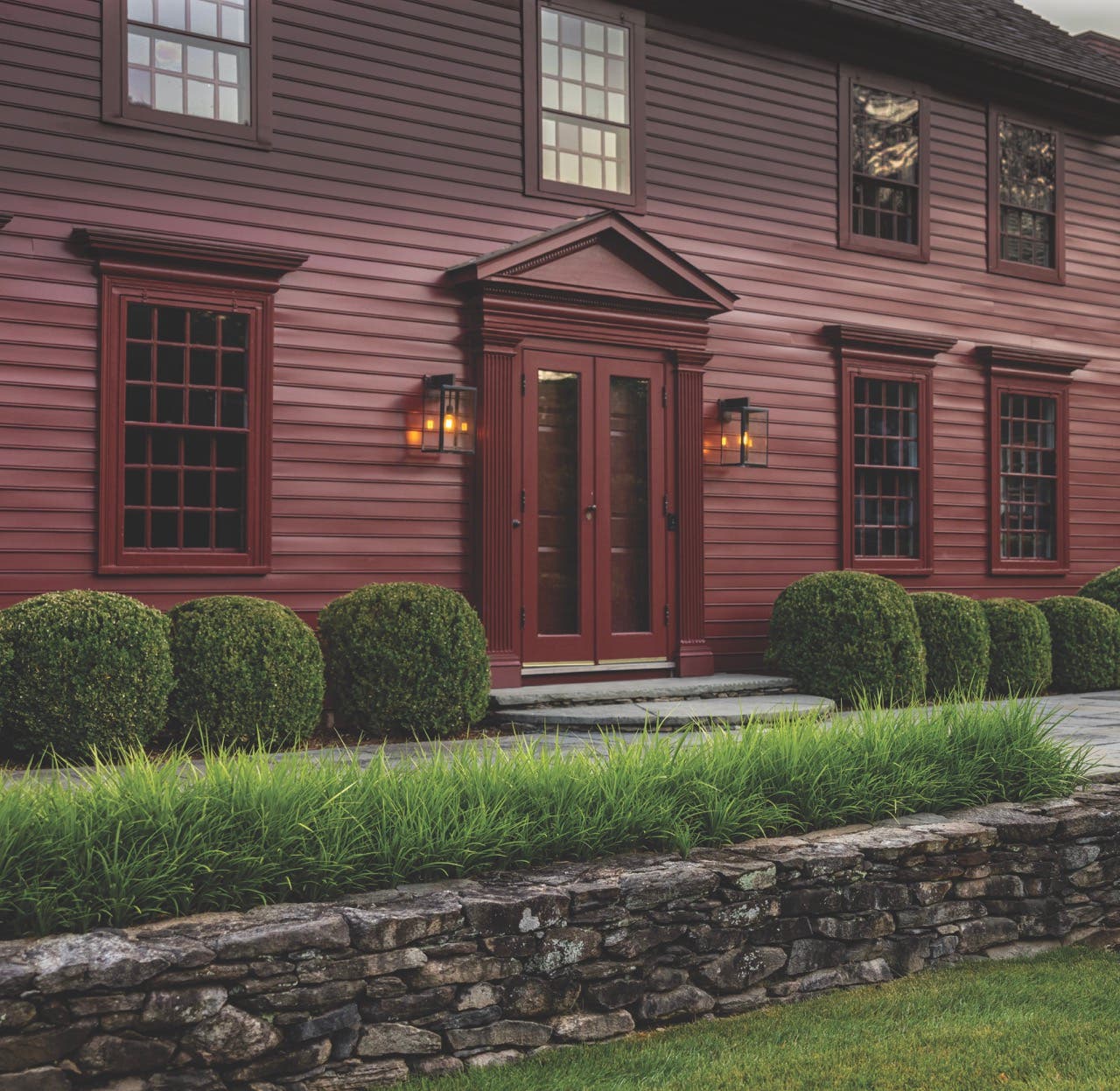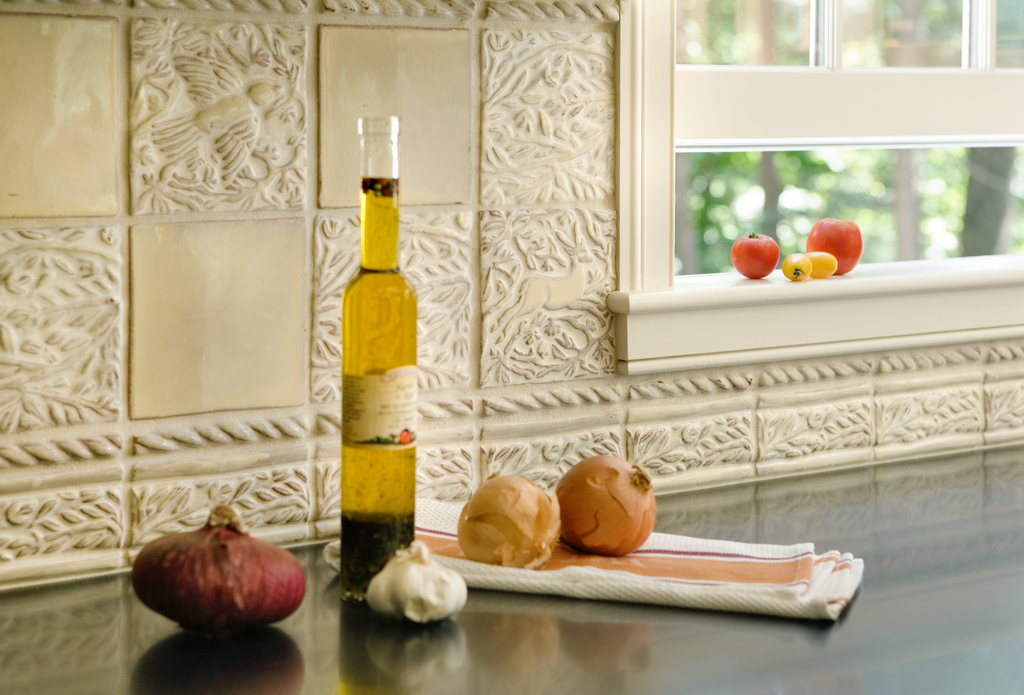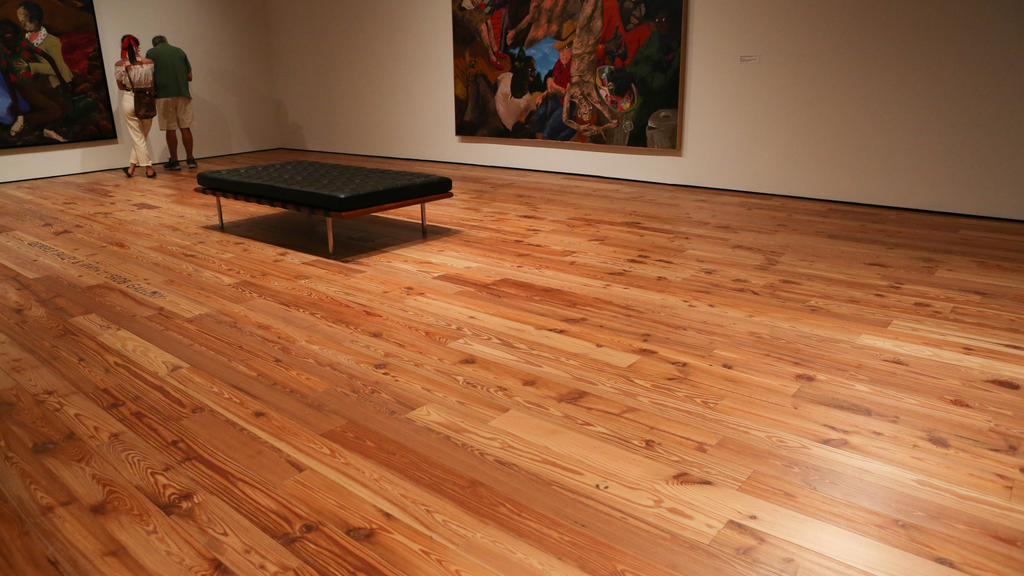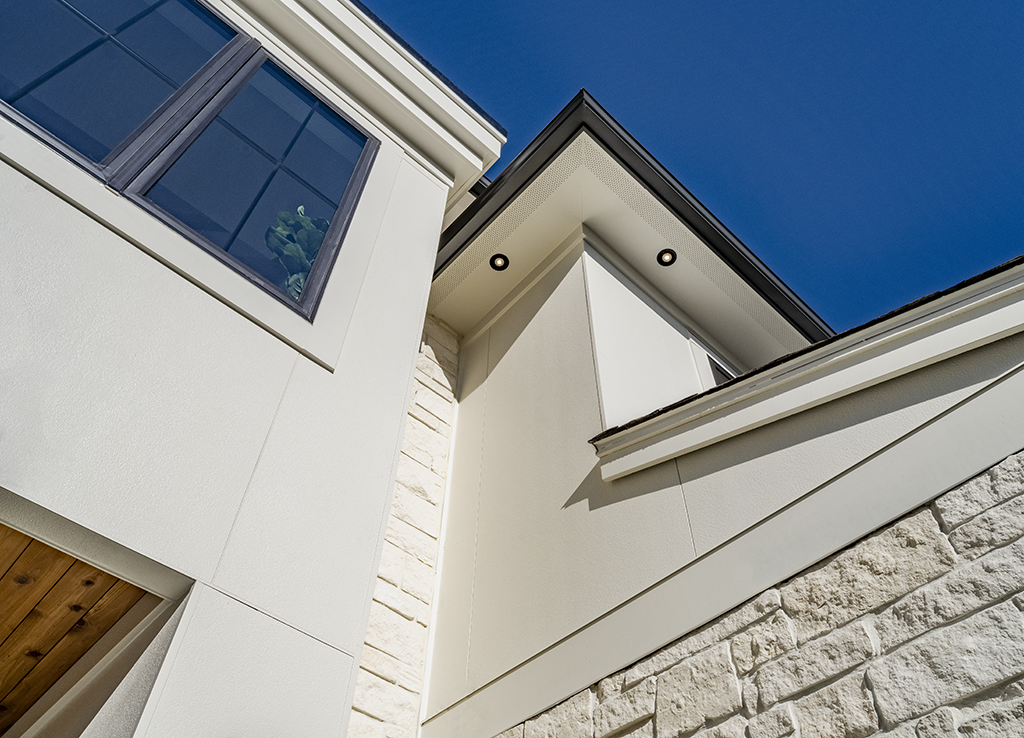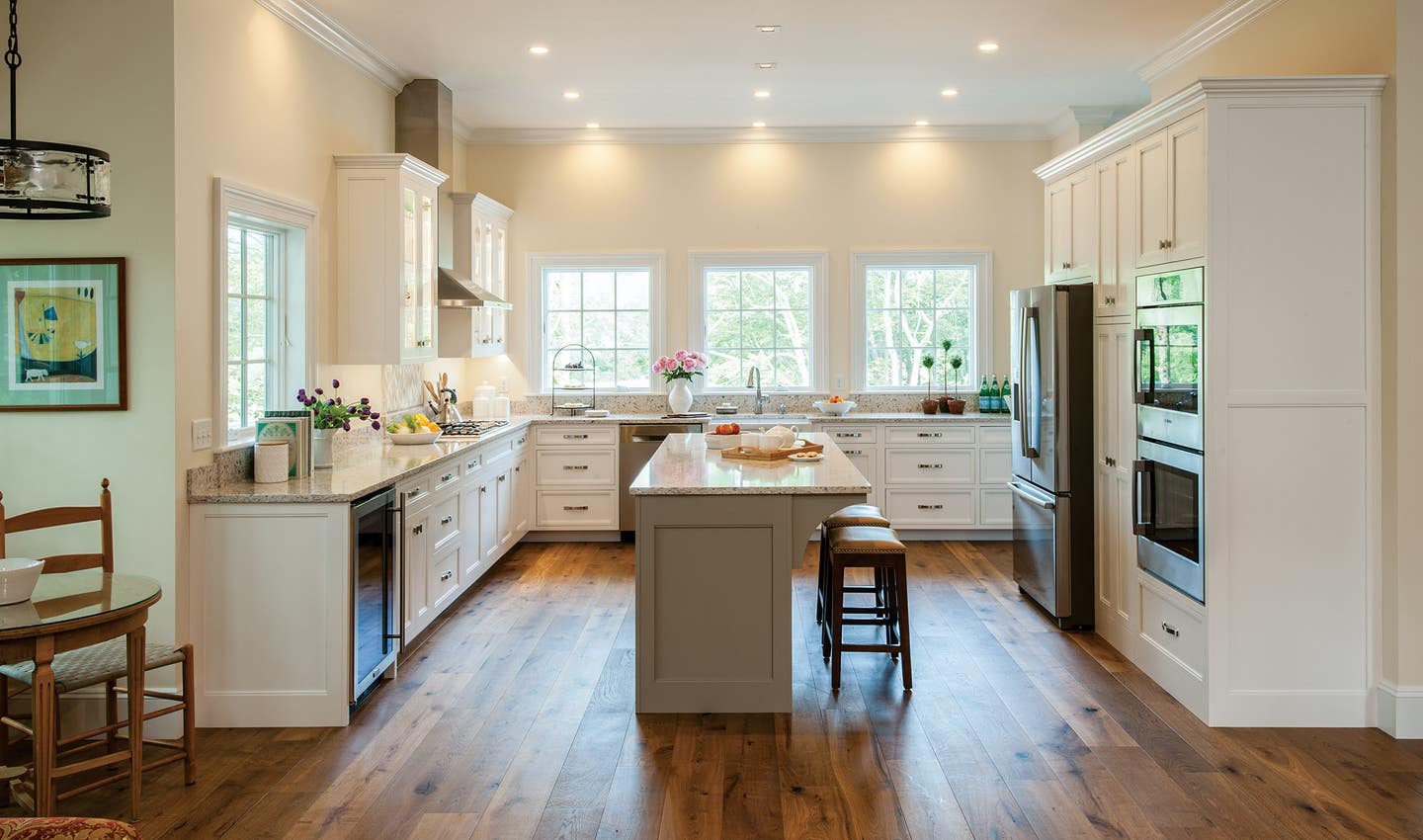
Product Reports
Cabinet Trends in Traditional Kitchens
Even kitchen cabinetry within the staid stylistic space of the traditional has always followed trends, shifting to accommodate new lifestyles, appliances, or simply the cooking tastes du jour. Today, cabinets are on the move again, as a quick look at what’s in and out reveals.
Perhaps the most telling trend is the increased talk of “transitional.”
“In general, I think we’re seeing movement toward a cleaner, transitional look,” observes James Stewart at The Kennebec Company in Bath, Maine, “one that even incorporates some frameless construction, but is still inspired by traditional woodwork and cabinetry.”
What makes a cabinet transitional? Definitions vary, but typically it is in details that are somewhere between traditional and modern. Framed, full-overlay doors and drawers on nontraditional frameless cabinets are common. Doors and drawers are usually paneled, but cabinet mid-rails don’t exist. “The majority of what we do is inset cabinetry,” says Nina Archambault at Crown Point Cabinetry in Claremont, New Hampshire. “It’s what people expect from us, but we also do frameless, full-overlays and have steadily increased that business.” She says they find those projects more in cities like Boston and New York.
Paula Accioly at Jewett Farms + Co. in Boston agrees. While her company is known for their Shaker doors with no edge beads or thumbnails, they’re also doing what they call modified inset. “These are overlay cabinets, but with fames only in the ends.” Nonetheless, she too still sees cornices at upper cabinet tops, and even supporting brackets or modillions underneath.
Another development is the growing draw of drawers. “We find that people are really interested in storing everything in drawers—pantry items, dishes, food—because they’re easier than opening doors and pulling roll-outs, a two-step process,” says Archambault. “Plus, they’re all below the counter, so you’re not reaching up.” More drawers also move the kitchen away from a stock-style appearance to look more like pieces of furniture, “and that elevates the design a bit.”
Stewart’s clients seem really pleased with more drawers. “You can achieve nice, symmetrical looks by putting banks of drawers flanking the range at its sides. And with today’s hardware, you can store cast-iron pans and not worry about the performance of the slides. It’s a lot easier on your back.”
Accioly, however, points out that a drawers-only kitchen may not look as good as a balance of doors and drawers. “It pays to keep design principles in mind. You can have drawers, but you need to change it up a bit.” Mechanicals like trash bin pulls and magic corner hardware can help here. “We try not to do very large drawers, keeping them under 36 inches wide.” In fact, since her company does single face-frames—uninterrupted by dividers—they try not to do any run of cabinets more than eight feet long.
With drawers close to dominating kitchens, is it game over for overhead cabinets? “One trend is not a lot of upper cabinets,” reports Archambault. “We’ve been doing nice floating shelves, rather than wall cabinets, for the last seven to 10 years.” She says they’re all exposed, on “super-strong brackets” so they can store heavy items. “Oftentimes they’re a contrast with painted cabinetry—say, rustic woods or natural walnut—so it’s a more open look than just cabinets, cabinets, cabinets.”
In fact, Accioly says, a lot of people come to her with kitchens that have no wall spaces. “They’re mostly windows, so there’s few places to put upper cabinets. Also more people want to use walls for artwork, lighting, or windows, so they end up storing everything in the base cabinets.” Drawers with plate pegs can stable all manner of dishes, plus casserole ware and bowls, but there’s a limit. “If you have items like lobster pots that won’t fit in a regular drawer, you need roll-outs.”
Those cabinets that hide all the toasters and blenders that clutter countertops may be the new lazy Susans—instantly dated. Accioly says they’re being replaced by hutches—that is, cabinets that reach down to the counter to stable, say, a coffee station or a command center with a laptop.
Of course, what’s old can become new. Stewart says his company’s hand-planed Eastern White pine cabinets are not just in farmhouse-style homes in New England. “Texture is gaining importance in people’s kitchen decisions—reclaimed flooring, brushed countertops—and with their traditional woodworking techniques, these cabinets have texture.”
Life Beyond White
Time was, the only kitchen better than all-white was off-white, but—gasp!—color is creeping back into cabinets. “We still do white,” says Archambault, “but different shades of grey are probably the hotter colors at this point.” She adds that Navy blues and sea blues have become really strong. “Navy blue is a classic color and not so unique that no one else will want it when your house is up for sale.”
Says Stewart, “I think grey initially started to transition into grey-blue, and then blues into grey-greens, which really opens up the color palettes. And honestly, we’re seeing a lot of black.” Not exclusively black kitchens, he says, but perhaps a black island with a grey or white perimeter. They’ve done gloss black and dead flat, matte black. “You don’t think of black as being a soft color, but it communicates really nicely when it has a low sheen.”
Accioly, too, sees new tones. “They’re getting darker, like olive green, and dark charcoal, and darker blue.” She’s also fond of Rubio Monocoat, a natural oil finish, especially on oak. “It has all kinds of colors—blue, grey, and whitewash—and it displays the oak grain structure.”
It may be a reach to say every new million-dollar house must be filled to the brim with weathered, wormy barn boards—but not by much. “Reclaimed lumber started very quietly, but is really in strong demand,” says Archambault. “We do a lot with accents, so maybe a painted kitchen with a one-of-a-kind island out of reclaimed chestnut or oak or pine. The juxtaposition of rustic and modern is popular too.”
Walnut, once among the royalty of cabinet woods, is having its own revival. “It’s one of those woods that went away for a long time,” says Archambault, “but in the last five years has come roaring back and is now super-hot.” Stewart concurs. “In our work, 15 years ago we didn’t see any walnut; it was all cherry. Now it’s actually rare to see a cherry kitchen.” He says they’ve done a few contemporary projects with cypress and vertical grain Douglas fir—woods that are not traditional for New England. “However, if there’s a trend, I’d say it’s toward the quarter-sawn white oak Arts & Crafts look that’s gaining popularity yet again.”
Accioly as well does a lot with reclaimed woods. “However, we don’t see it in abundance in one kitchen. It’s always in details, like the floating shelves, or inside the cabinets or maybe just the island is reclaimed wood.”
Though all agree that stainless appliances look better than ever, Stewart says he still strongly recommends hiding the dishwasher behind a wood panel. “We put a lot of effort into designing around people’s beautiful sinks, and it’s a shame seeing an appliance right next to one. With a nicely done panel, you can blend right in with the line of cabinetry.” This creativity is part of what Archambault says they’re doing with their newest line, Crown Select. “It’s a limited custom line, with a menu of details based upon our 40 years of experience, but value-engineered so it can be offered at a lower price point.”
Accioly says they even do appliance panels on beverage centers and wine coolers. “You leave the glass exposed, and then the frame around it in a cabinetry front.” However, it all depends upon the layout of the kitchen. “Stainless steel appliances do look great, but if you have a small area, a dishwasher or stainless-steel appliance kind of breaks the run of cabinets. For people who want that built-in or fitted look, not breaking up the run makes the room look more spacious.”
As for panel carpentry in general, Stewart reports that raised panels were more common 10 to 15 years ago. “They’re still seen in, say, New England Georgian homes with earlier American architecture, but I think a cleaner, flat panel is more widely used now, even in a lot of our restoration work.” Archambault agrees. “I think traditional raised panel doors are one of those things that has faded over time.” She sees them perceived as an old-fashioned look, but reflecting on her two decades in the industry she adds, “But who knows? They could come back!”
Hitting on Hardware
Lest you think that the decorative hinges, pulls, and catches that make cabinets work do not cycle in and out of fashion, think again. “Brass is back,” explains Archambault. “In decorative hardware for cabinetry, in fixtures like faucets, and in lighting, we’re finding a lot of demand for it.” She says, however, that today’s brass is brushed and unlacquered. “It’s a more contemporary feel, unlike the 1980s lacquered brass that almost looks like plastic.” Stewart agrees. “Brass is back, yes, but so is polished nickel,” noting that the satin nickel and brushed nickel phase seems to have run its course. “Polished nickel is a more formal, high-style look that is easy to match up with plumbing fixtures.”Accioly says whatever style of hardware is in vogue, she strives to carry it over to appliances. “We can do the same hardware used in the cabinet drawers in the dishwasher, but in different sizes, so it looks exactly the same.”
Gordon Bock, co-author of The Vintage House (www.vintagehousebook.com), is an in-demand speaker for courses, seminars, and keynote addresses through www.gordonbock.com.




